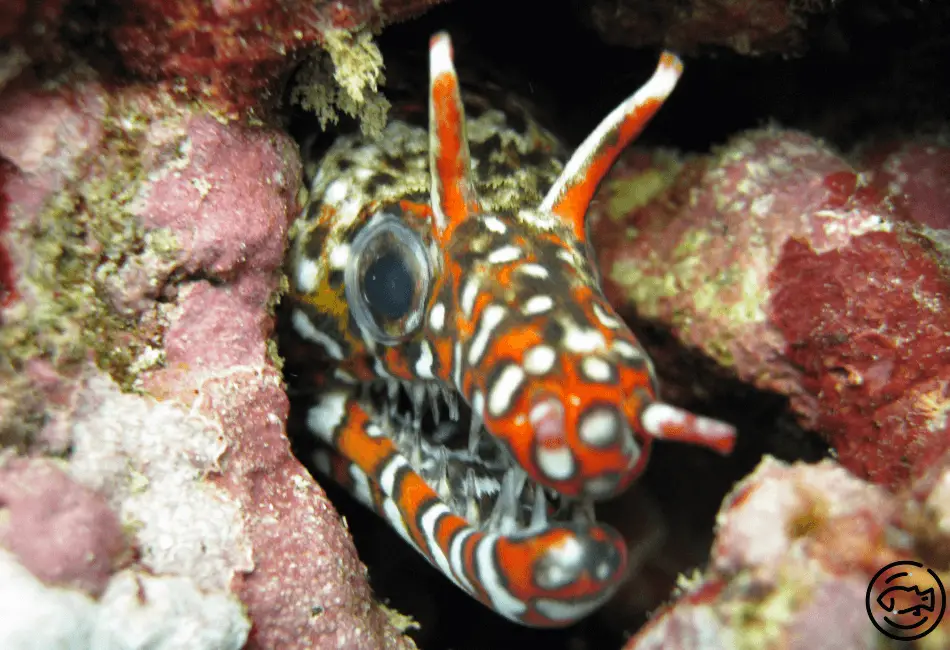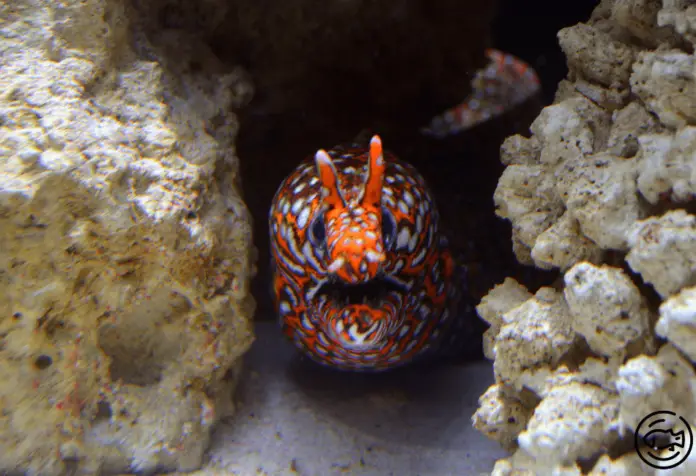If you are a proud keeper of a spacious marine aquarium and want to add a striking & impressive specimen to your collection, consider the Dragon Eel.
This guide aims to provide you with the necessary information to keep this aggressive creature in your home aquarium.
Species Overview
The Dragon Eel, scientifically known as Enchelycore pardalis, is a member of the Muraenidae family and boasts a unique appearance. With its curved jawline, striking orange to red head stripes, and elongated nostrils resembling horns, this creature stands out in any collection.
Originating from the Indo-Pacific Ocean, Southern Japan, and Hawaii, the Dragon Eel is a nocturnal predator with a rare presence. Despite not being endangered, the eel is known for its hiding habits in rocky crevices and coral reefs.
Other common names for this magnificent species include Dragon Moray Eel, Dragonface Moray Eel, Hawaiian Dragon Moray Eel, and Japanese Dragon Eel.
As a bottom dweller, the Dragon Eel calls rocky formations and caves home, using them as hunting grounds as well as shelter. Its unique sense of smell allows it to locate prey even in the darkest corners of its territory.
Appearance

The Dragon Moray boasts a remarkable and vibrant appearance, with a colorful blend of hues such as orange, black, yellow, red, and white adorning its entire body length.
This species of Moray Eels is known for its large, menacing jaws lined with razor-sharp teeth and its protruding horns above the eyes, which earned it its distinctive name of Dragon Eel.
There are no physical distinctions between male and female Dragon Moray Eels, though some specialists state that males tend to exhibit more striking colors.
Among all variations of the Dragon Eel, the Japanese Dragon Eel is considered by some to be the most visually striking. However, the coloration of each specimen can vary significantly within populations.
Care Of The Dragon Eel
The Moray is a species that inhabits the ocean, and maintaining one as a pet in a home aquarium can prove challenging.
Therefore, it is advisable for individuals with a vast, well-established reef aquarium and prior knowledge of their requirements to consider owning one of these stunning creatures.
Owning a Dragon Eel Moray in a large reef aquarium can make a truly eye-catching addition to your collection.
Behavior
The Dragon Eel, a magnificent predator, may exhibit shy behavior upon arrival in its new habitat. During this acclimation period, it will likely spend most of its time concealed until the lights are off when it ventures forth to forage and hunt.
Once acclimated, the Dragon Eel may occasionally bask in the open or spend much of its time with its head protruding from a rock cave or other concealed location.
In the event of a perceived threat, the Dragon Eel will engage in a captivating display of aggression, featuring wide-open jaws, flattened gills, a tilted head, and an erected dorsal fin. This display is usually enough to cause other tank inhabitants to retreat safely.
Tank Conditions
The Dragon Moray Eel necessitates a spacious habitat, ideally measuring 180 gallons or more, complete with a secure hiding place for the creature to retreat to during acclimation.
As the species matures and can grow up to 36 inches in length, it is important to consider the length of the aquarium rather than its height. An aquarium that is a minimum of two feet in length and equipped with a secure lid will provide a suitable habitat for this bottom-dwelling species.
It is also crucial to note that while the Japanese Dragon Moray is considered reef-compatible due to its reluctance to feed on corals, its size and potential destructiveness to reef habitats, as well as its tendency to consume smaller species commonly found in reef tanks, make it an unsuitable addition to a reef aquarium.
Water Parameters
The Dragon Eel is an aquatic inhabitant which necessitates a saline environment.
This species originates from temperate regions and must be provided with water temperatures ranging between 660 to 770 degrees Fahrenheit.
The ideal pH levels should be in the range of 8.0 to 8.5, dKH between 8 to 12, and salinity between 1.02 to 1.026.
also read: Can Box Turtles Swim?
Diet
The Dragon Moray Eel is a carnivorous species that lives on a diet of squid, octopus, and live feeder fish in its natural oceanic environment.
It is known for consuming various prey, including fish that are larger than its wide jaws, leading to the need for caution when selecting tank mates.
Once adjusted to its aquarium surroundings, the eel can be offered nourishment in the form of raw fish strips, such as haddock, smelt, and squid.
To entice the eel to feed, the food can be presented by using feeding tongs and waving the strip in front of its head, allowing the Moray to detect its scent.
How Often Should You Feed Your Dragon Eel?
The process of acclimating the Japanese Dragon Eel to an aquarium environment can take some time; hence it is expected if the newly acquired specimen abstains from eating initially.
It can go weeks or even months without consuming food. In such scenarios, providing live shrimp or feeder fish and maintaining low lighting to mimic its natural nocturnal feeding patterns is recommended.
It is crucial to avoid overfeeding the Dragon Moray, as excessive food intake can lead to liver disease due to liver fat infiltration. Research has demonstrated that Morays consume food infrequently.
Thus, it is advisable to offer food to the specimen just twice a week, providing just enough to consume within a couple of minutes. Additionally, overfeeding may cause the Eel to vomit partially digested food, causing a significant mess in the tank.
If the Eel refuses to eat, it could be due to overfeeding, decreased water quality, or an abrupt decrease in water temperature. One can perform a partial water change, provide a different food variety, or exhibit patience in such cases.
When feeding the Eel, caution should be exercised as they have poor eyesight, which is compensated by their acute sense of smell. This can lead to accidental biting when hand-feeding; therefore, it is recommended to use metal feeding tongs instead of bare hands.
The bite from an eel can result in a severe bacterial infection; hence in case of a bite, the wound should be thoroughly cleaned and disinfected, and medical attention should be sought if the area is itchy, swollen, red, or painful.
Tank Mates
Dragon Morays are known for their territorial and hostile behavior. To prevent aggressive encounters, it’s crucial to only house adult specimens in the same tank if they are a bonded pair or if your aquarium exceeds 180 gallons and offers ample hiding spaces for each resident to avoid confrontation.
However, it’s possible to house juvenile Dragon Eels with other eels, but adult Morays may attack them, particularly if new eels are added to the tank later.
Also, ensure that all the eels have similar or slightly larger sizes than the Dragon. For aquariums larger than 200 gallons, several fish species can peacefully coexist with the Japanese Dragon Eel and provide a visually captivating display. These fish can defend themselves and should be left undisturbed. Some of these species include Lionfish, Triggerfish, Puffers, Groupers, Snappers, and other comparable large species.
Breeding
To date, breeding any species of Moray Eels in captivity remains a challenge.
This is due to the young eel’s leptocephalus phase, which undergoes a planktonic larval stage, drifting on ocean currents for several months before becoming a recognizable juvenile.
Efforts to recreate these conditions in captivity have thus far failed.
As a result, all Morays available for sale are sourced directly from their natural habitat.
Health
The resilience of these creatures is remarkable once they have acclimated to their new surroundings. Provided that you have a robust filtration system and the water conditions are optimal, the Moray Eel is known to be one of the most robust marine species to keep in captivity.
However, it is important to note that Moray Eel’s scaleless skin makes them susceptible to treatments that contain copper. Hence, while these creatures rarely fall prey to parasitic illnesses, it is advisable to utilize medication that is free of copper when necessary.
On rare occasions, bacterial infections may arise due to trauma during transportation or handling or due to subpar water quality. Fortunately, Moray Eels have been observed to respond positively to antibiotics.
When selecting your Dragon Eel, it is crucial to perform a thorough inspection. This may require that you request the dealer to coax the creature from its lair in the holding tank.
Be vigilant for any signs of physical damage or cloudiness in the eyes. As with any new addition to your setup, it is advisable to quarantine the eel before integrating it into your system.
Availability
The Enchelycore pardalis is not a commonly found species in conventional pet stores. However, it can be procured from a specialized saltwater dealer.
One can anticipate paying a minimum of $800 for a 12-inch juvenile specimen, with prices reaching up to $2,000 for a fully-grown eel.
It is important to remember that shipping fees may also apply, particularly when ordering from an online retailer.
It is advisable to contact the supplier or aquatic specialist to know about the availability before placing an order.
For online purchases, it is recommended to select a U.S.-based supplier, even if it means waiting for a suitable eel to become available.
This minimizes shipping costs and increases the chances of receiving a healthy and viable specimen upon arrival.
Conclusion
The Japanese Dragon Eel is a distinctive, vibrant saltwater predator that could add a touch of elegance to any display aquarium.
Nevertheless, inexperienced hobbyists may have better choices due to its costly acquisition, limited compatibility with other tank inhabitants, and demanding maintenance requirements.
If you have a substantial reef aquarium complete with a diverse array of semi-aggressive, large fishes and an appropriate rocky environment, then, in that case, you can consider acquiring a Dragon Eel.



